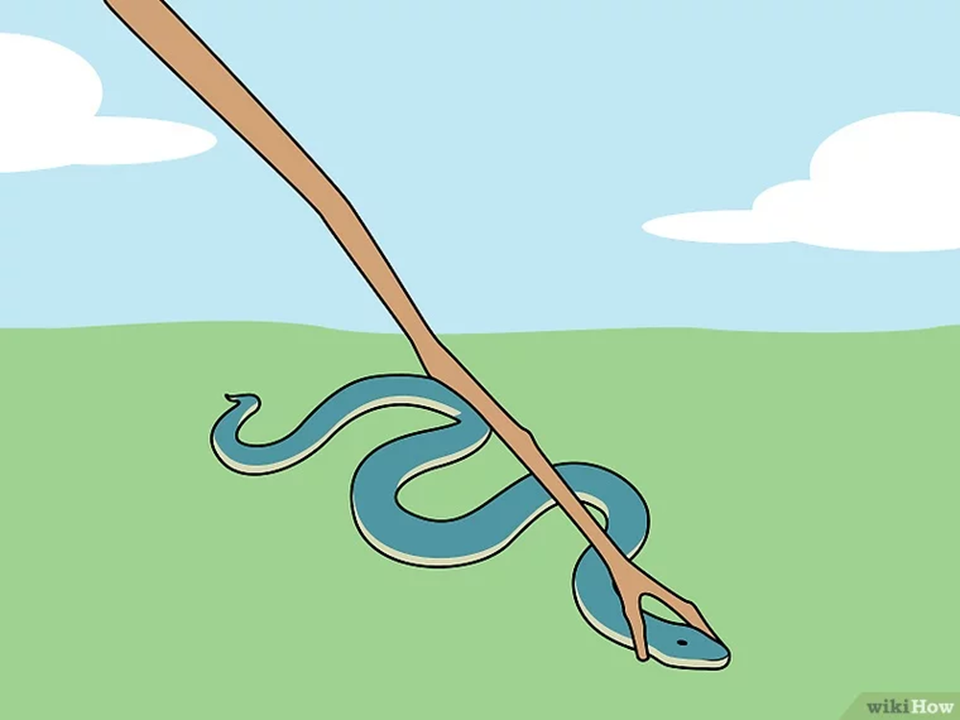
How to beat Goliath
Because size doesn’t matter
I have formulated 6 rules which I call David’s rules. These are for anyone facing the big one ...
Snakes have always had a fascination for us. We fear them, some people worship them, we hate them, and we kill them. Those who don’t do any of this and instead, appreciate them for what they are; rodent controllers, snake population controllers and just plain law-abiding citizens with as much, if not more, right to be left alone in peace, than we do, are a rare breed. The reason is the prevailing ignorance about snakes and the proliferation of myths. Ignorance breeds myths and that leads to hatred. This is the basis of all stereotyping, demonization and violence; ignorance about the subject. Applies to all subjects, be they snakes or people.
Snakes are among the most beneficial of creatures. They are not slimy, cunning, or treacherous. They don’t bear grudges. They don’t photograph your face in their minds and come into your bedroom in the night to bite you. People do all those things. Not snakes. Snakes, like all animals, are concerned only about two things; food and safety for themselves and their young. You, human being, are not their food. And if you don’t threaten them, you can literally sleep with a snake in your bed and remain perfectly unharmed. Not that I am advocating that. But there have been cases of campers finding a snake in their sleeping bag, because it was a cold night and the sleeping bag, warmed by a warm body was a very nice place to be for a cold-blooded reptile like the snake. The camper was sensible, didn’t thrash around, moved very slowly, unzipped his bag and rolled out and then shook the snake out of his tent. It can be as simple as that. It can of course be much more complicated and dangerous. The choice is ours. Not the snake’s.

I’ve lived a lot of my life in forests and was introduced to snakes by people who didn’t fear them. I learnt how to catch them, I had some as pets (also don’t advocate that) and I rescued several from death at the hands of my fellowmen. This fear and hatred of snakes is not instinctive as some would have us believe. It is a conditioned response thanks to the way we raise children. You may have seen some videos of small children playing with huge Burmese pythons. They are totally unafraid and treat the snake like they would, any toy. Having said that, it is highly inadvisable and very stupid to leave a small child with a huge snake. The reality is that love, loyalty, tenderness, and compassion are all human emotions, even if we don’t seem to see them too much nowadays. Snakes are eating machines. If they are hungry then whatever is edible is food. Your little kid is very edible. As long as a python is full, it won’t bother the child, but if it gets hungry, it will treat prey as any predator. I was in Kwantu Private Game Reserve in Port Elizabeth one winter. Kwantu is a wonderful place well worth many visits, with all the Big Five of Africa on the reserve and fabulous food in a very luxurious hotel when you get back from your game drive.
In the evening, a local Afrikaner farmer came to the reserve to do a little talk-show with his pet African Rock Python (Python sebae), and an African Rock Monitor (Varanus albigularus). I was struck by how he explained the danger of treating wild animals like we treat humans or domesticated animals like dogs. He said, ‘Imagine that I am working with a lathe machine for thirty years. I take care of that machine; I oil it and polish it and clean it and use it with great love. But one day I am careless, and it takes my thumb off. That is how it is with these animals,’ he said, pointing to the snake and lizard. ‘They are eating machines. If they are hungry, you are food. If they are not hungry, you are a prop like a tree branch or a rock. When the snake is draped round my neck, I am a tree for him. But when he is hungry, he can tighten his coils and if he is large enough and I am small enough, the result is predestined.’ So, while an irrational fear of snakes is, well, irrational, overconfidence about them and becoming careless can result in very painful and even fatal outcomes. Knowledge is the key.
I had a pet Boa Constrictor when I lived in Kwakwani, on the Rio Berbice in Guyana. Once when driving through the rain-forest, back from one of the mines I saw it very lethargically crossing the road and I picked it up. It was about 8 feet long. I built a large wooden box fronted with a mesh, as its home and put a thick tree branch for it to climb on. It would spend most of its time draped over the log, basking in the sun. The cage was under a tree and so if it got hot, the snake would glide over into the shade. Sometimes after it had recently eaten, I would take it out in the morning, and it would coil itself around my arm or leg for warmth. All quite friendly.
I used to feed it live chickens, which it would catch and eat. It wouldn’t eat dead meat. The interesting thing was that it never caught the chicken while I was watching. It would simply lie there, totally still, draped on the branch. The chicken would settle down after being put into the cage, totally unaware that there was a snake in the cage with it. After all these were battery reared broiler birds which had never seen anything other than other chickens. Then when I returned after a couple of hours, I would find the chicken gone and a lump inside the snake. One day the snake escaped. It wedged itself in a corner and pushed the two-inch planks, nailed together, apart and left for the forest. Mercifully all this happened in its natural environment and the snake went back to where it came from. If not, this would have been a potential hazard.
Keeping wild animals as pets is not a good idea at all. Whether that is snakes or anything else. Wild animals must be left in their natural habitat and enjoyed there, watching and photographing them. Taking them out of their environment is cruel on them and if they escape or are released in an alien environment, they can become a major problem, like all the Burmese pythons in Florida. They have no natural predators in the new place, breed unchallenged and prey on local species which have no defence against them and become a major hazard. All because someone thought the little snake was cute and wanted it as a pet and then when it grew to its normal size, they couldn’t cope with it and released it in the nearest piece of bush they could find, imagining that they were doing a good deed. The rest is painfully clear. Please don’t keep any wild animal as a pet.
I lived and worked in tea and rubber plantations in the Anamallais and Kanyakumari District in Tamilnadu for ten years. The plantations were an interesting place where strange things happened as a matter of course. Over the years, I learned never to be surprised at anything. In the Iyerpadi Hospital where Dr. John Philip was the RMO, a man was brought in after having been bitten by a cobra on his face. How this happened is a story in itself. This man had the reputation of knowing some sort of magic spell that he claimed neutralized the effect of snake venom. He would catch snakes and get them to bite him on his hand and then show people that nothing happened to him. This naturally gave him a lot of ‘brand’ in a place as superstitious as Anamallais was. The reality is that most snakes are non-venomous to begin with and those that are venomous usually don’t inject a full dose, either because they had hunted recently and had used up their poison on their natural prey – rats and other rodents – and have not regenerated a new supply. The long and short of it is that many people who die of snake bite die more out of fear or because they didn’t get medical aid in time.
In this case, however, our friend chased a cobra, which tried to escape down a hole in the embankment by the side of the road, but he caught it by the tail and hauled it out and then caught it behind its head and kissed it. He was himself sloshed out of his mind at the time and his bravado far exceeded his intelligence. The result was that the snake reciprocated the affection and he was bitten twice or thrice on the face. Given that this snake did have some venom to donate and that he was bitten on the face, the man collapsed. Mercifully, some people saw him and brought him to the hospital. At the hospital, there was no antivenin and so Dr. John gave him some antihistamine and put him on the ventilator, while they sent for antivenin. Now, the interesting thing was that the hospital didn’t have an electrical ventilator. What they had was a mechanical device which was like a bellows and needed someone to sit there and pump it constantly to ensure that the air supply continued uninterrupted. It was amazing how everyone in the hospital, nurses, doctors, other patients, their visitors, passersby who heard the tale, including my wife and I, all came to the aid of the man and took turns to keep the air flowing into the lungs of the man who was completely comatose. This continued day and night, hour on hour for 48 hours, and then we beheld that the man’s eyes opened, and he sat up and a couple of hours later he was as good as new. His love of kissing snakes though, had dampened a bit. I asked Dr. John about this ‘miraculous’ event. He told me, ‘No miracle at all. The poison is neurotoxic, but protein based. It affects the nerves and stops the breathing. But being protein based, if you can keep the patient breathing mechanically by forcing air into his lungs, when the poison naturally degenerates within 48 hours the patient can breathe again’. However, miracles are far more fun to believe in than science and so our friend’s stock went up even higher after it was ‘proved’ that snake venom had no effect on him. The fact that he was in a coma and had been kept alive mechanically for 48 hours was soon forgotten because it came in the way of the belief in the nice miracle. Shows how such beliefs thrive in all parts of the world, whereas the truth lies either in some straightforward physical reason or in less straightforward skulduggery and playacting.
Most recently, I had the opportunity to rescue two snakes, both pythons, one in Sri Lanka and one in India. In Sri Lanka my friends and I were camped in the Yala National Park, which is a real heaven on earth, rivaled only by Wilpattu. I can’t decide which is more beautiful. We were all relaxing or more accurately, recuperating from the morning drive, waiting for lunch to be served. Suddenly, the bearer came rushing in and said, ‘There is a Thith Polanga (Russel’s Viper’).’ He had good reason to be afraid as the Russel’s Viper has the record for highest number of fatalities in Sri Lanka. It’s poison is particularly venomous exceeded only by that of the Saw-scaled Viper.
More about this snake here http://itsmejumbo.blogspot.com/2013/08/russells-viper-ultimate-viper-in-sri.html
All of us leapt out of our beds and ran outside to see what the bearer had discovered. Think of ten reasons why your sink may be blocked. I bet one of them is not, “6-foot young python lost his way.” That’s what had happened. The cook and his helper first thought it was a Russell’s Viper and wanted to kill it. But I identified it as a young python who got there chasing the little frogs of which there are a profusion. He slid up the drainpipe and got stuck. The standard solution was once again proposed but I vetoed it. I then caught it and released it in the forest. Did wonders for my mystique. I wisely remained silent about the fact that what I did was easier than taking off my hat. Sometimes silence does more for you than all the talk in the world. It is not surprising that the bearer thought it was a Russel’s Viper because there is some similarity in markings. But that is where it ends. The young python was totally harmless and would have been in danger of meeting a nasty end thanks to people’s fear of snakes. Snakes are highly beneficial in that they keep rodents under control. Had it not been for snakes we would be run over with mice and rats. My friend Ifham took a video of the event. So much for a lazy afternoon in the bush.
In early July, I was returning from Madurai on a late flight and driving home. The flight was more than six hours late and it was past 1 am when nearing my house, I saw a crowd of people gathered around a traffic island. I stopped the car and got out to see what the excitement was all about and discovered that a large Rock Python had been trying to cross the road from the forest on one side and had got stumped by the traffic island. People who saw it, mercifully didn’t try to kill it, but surrounded it, trying to protect it from traffic. That resulted in the snake being blocked from all sides and not knowing what to do. There was no time to call anyone, it was close to 2 am and I needed to do something to save the snake. I asked the people to stand back and went in to catch the snake. Free advice and warnings were fast flowing. “Uncle don’t touch it. You will die.” “Uncle, this and that and whatnot.” I asked them, “If I don’t touch it, it will remain here and so will you, all night. So, what shall I do?” That made them think and as they fell silent. I went in, picked up the snake, holding it behind its head, supported his body with my other hand and carried it across the road, back to the forest he had come out of and released it in the forest. Thankfully a happy ending for the snake’s adventure. The snake was about 9 feet long and weighed over 10 kilograms.
Which brings me to the question, “What must you do if you see a snake?” The answer must begin with another question, “Where did you see the snake?” The reason is that what you do, depends on where you see the snake. Let me explain.

Here is a very good article with diagrams about how to catch a snake. https://m.wikihow.com/Catch-a-Snake Please DON’T try any of the snake traps that are mentioned in the article. Never catch a snake unless it is an emergency.
Finally, to address some questions that a dear friend asked. Please ask your own.
Question: When picking up the snake, it tends to instinctively coil around the hand or leg. Should I be trying to uncoil it, while picking it up and attempting to release it? As I’m among those who are the conditioned to be scared of snakes, cooling/uncoiling looks and feels creepy.
Answer: No, you should not uncoil them. If you hold them properly, they won’t be able to coil at all. If they do, leave that alone until you get to the release point. Then gently uncoil and release. The coiling gives it comfort. So, leave it alone. As for feeling creepy, that is a conditioned response. The only way to get over it is to handle snakes.
Question: How much of a “choke hold” is acceptable versus necessary?
Answer: First of all, you are not choking the snake at all. You are only securing his head so that he doesn’t bite. Even non-venomous snakes can bite extremely painfully and will do so because they don’t know your good intentions. To them, you are a major threat and they are trying to get away from you while you are bent on catching them. Hold firmly. I use the thumb and two fingers with the other fingers supporting from below. Hold firmly but not too tightly. The more painful the hold is for the snake, the more it will struggle to get out. If you hold it evenly and firmly, it will relax.
Please log in to leave a comment
Loading comments...

I have formulated 6 rules which I call David’s rules. These are for anyone facing the big one ...

One of my friends who comes from ...
I have said this a million times, if I have said it once – the three crimes committed on society with society’s blessing are: Commerci...